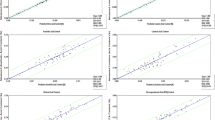Abstract
A rapid and efficient method for oil constituent estimation in intact sesame seeds was developed through near-infrared reflectance spectroscopy (NIRS) and was used to evaluate a sesame germplasm collection conserved in China. A total of 342 samples were scanned by reflectance NIR in a range of 950–1650 nm, and the reference values for oil content and fatty acid (FA) profiles were measured by Soxhlet and gas chromatograph methods. Useful chemometric models were developed using partial least squares regression with full cross-validation. The equations had low standard errors of cross-validation, and high coefficient of determination of cross-validation (R 2c ) values (>0.8) except for stearic acid (0.794). In external validation, r 2 values of oil and FA composition equations ranged from 0.815 (arachidonic acid) to 0.877 (linoleic acid). The relative predictive determinant (RPDv) values for all equations were more than 2.0. The whole-seed NIR spectroscopy equations for oil content and FA profiles can be used for sesame seed quality rapid evaluation. The background information of the 4399 germplasm resources and accessions with high linoleic acid content identified in this study should be useful for developing new sesame cultivars with desirable FA compositions in future breeding programs.


Similar content being viewed by others
References
Yoshida H, Tanaka M, Tomiyama Y, Mizushina Y (2007) Regional distribution in the FAs of triacyglycerols and phospholipids of sesame seeds (Sesamum indicum). J Food Lipids 14:189–201
Reshma MV, Balachandran C, Arumughan C, Sunderasan A, Sukumaran D, Thomas S, Saritha SS (2010) Extraction, separation and characterisation of sesame oil lignin for nutraceutical applications. Food Chem 120:1041–1046
Anilakumar KR, Pal A, Khanum F, Bawa AS (2010) Nutritional, medicinal and industrial uses of sesame (Sesamum indicum L.) seeds—an overview. Agric Conspec Sci 75:159–168
Betiku E, Adepoju TF (2013) Methanolysis optimization of sesame (Sesamum indicum) oil to biodiesel and fuel quality characterization. Int J Energy Environ Eng 4:9–16
Sato T, Maw AA, Katsuta M (2003) NIR reflectance spectroscopic analysis of the FA composition in sesame (Sesamum indicum L.) seeds. J Am Oil Chem Soc 80:1157–1161
Kim KS, Park SH, Choung MG (2006) Nondestructive determination of lignans and lignan glycosides in sesame seeds by near infrared reflectance spectroscopy. J Agric Food Chem 54:4544–4550
Batten GD (1998) Plant analysis using near infrared reflectance spectroscopy: the potential and the limitations. Aust J Exp Agric 38:697–706
Williams PC, Norris KH (2001) Near infrared technology in the agricultural and food industries, 2nd edn. American Association of Cereal Chemists, St. Paul
Wu JG, Shi CH, Zhang XM (2002) Estimating the amino acid composition in the milled rice powder by near-infrared reflectance spectroscopy. Field Crops Res 75:1–7
Sato T, Maw AA, Katsuta M (2004) Nondestructive near-infrared reflectance spectroscopic analyses of the major constituent of sesame (Sesamum indicum L.) whole seeds with different coat color. Plant Prod Sci 7:363–366
Sato T, Maw AA, Katsuta M (2006) Nondestructive near infrared reflectance spectroscopy of sesame (Sesamum indicum L.) components by single seed analysis. Plant Prod Sci 9:161–164
Li XD, Xiao L, Wu G, Wu YH, Zhang XY, Lu CM (2008) Accumulation pattern of fatty acids during the seed development of sesame (Sesamum indicum L.). Chin J Oil Crop Sci 30(1):84–89
Lindberg W, Persson JA, Wold S (1983) Partial least-squares method for spectrofluorimetric analysis of mixtures of humic acid and lignin sulfonate. Anal Chem 55:643–648
Windham WR, Mertens DR, Barton FE II (1989) Protocol for NIRS calibration: sample selection and equation development and validation. In: Marten GC, Shenk JS, Barton FE (eds) Near infra-red reflectance spectroscopy (NIRS): analysis of forage quality. USDA, Springfield, pp 96–103
Fontaine J, Schirmer B, Horr J (2002) Near-infrared reflectance spectroscopy (NIRS) enables the fast and accurate prediction of essential amino acid contents. 2. Results for wheat, barley, corn, triticale, wheat bran/middlings, rice bran, and sorghum. J Agric Food Chem 50:3902–3911
Montes JM, Utz H, Schipprack W, Kusterer B, Muminovic J, Paul C, Melchinger AE (2006) Near-infrared spectroscopy on combine harvesters to measure maize grain dry matter content and quality parameters. Plant Breed 125:591–595
Zumfelde T, Baumert A, Strack D, Becker H, Moellers C (2007) Genetic variation for sinapate ester content in winter rapeseed (Brassica napus L.) and development of NIRS calibration equations. Plant Breed 126:291–296
Patil AG, Oak MD, Taware SP, Tamhankar SA, Rao VS (2010) Nondestructive estimation of FA composition in soybean [Glycine max L. Merrill] seeds using Near-Infrared Transmittance Spectroscopy. Food Chem 120:1210–1217
Gomez KA, Gomez AA (1984) Statistical procedures for agricultural research, 2nd edn. Wiley, New York
Osborne BG, Fearn T, Hindle PH (1993) Practical NIR spectroscopy with applications in food and beverage analysis, 2nd edn. Longman, Harlow
Ha J, Koo M, Ok H (1998) Determination of the constituents of sesame oil by near infrared spectroscopy. J Near Infrared Spectrosc 6:371–373
Chen D, Cai W, Shao X (2007) An adaptive strategy for selecting representative calibration samples in the continuous wavelet domain for near-infrared spectral analysis. Anal Bioanal Chem 387:1041–1048
Acknowledgments
This work has been financially supported by the China Agriculture Research System (CARS-15), the National Natural Science Foundation of China (31301359) and Henan Scientific Research Fund (20137924). The authors wish to thank all anonymous reviewers for their constructive suggestions which lead to improvement of manuscript.
Author information
Authors and Affiliations
Corresponding author
Additional information
Y. Liu and H. Mei contributed equally to this work.
About this article
Cite this article
Liu, Yy., Mei, Hx., Du, Zw. et al. Nondestructive Estimation of Fat Constituents of Sesame (Sesamum indicum L.) Seeds by Near-Infrared Reflectance Spectroscopy. J Am Oil Chem Soc 92, 1035–1041 (2015). https://doi.org/10.1007/s11746-015-2658-8
Received:
Revised:
Accepted:
Published:
Issue Date:
DOI: https://doi.org/10.1007/s11746-015-2658-8




